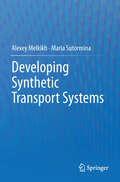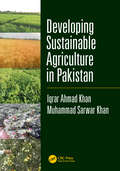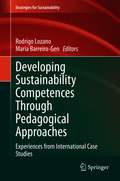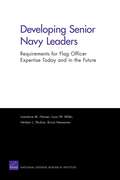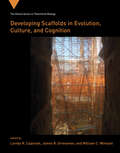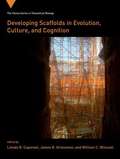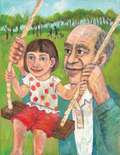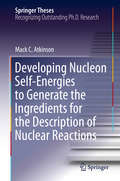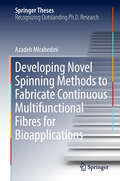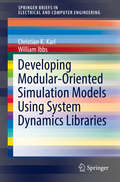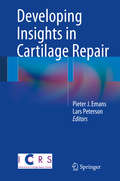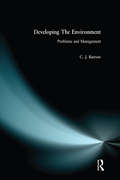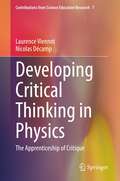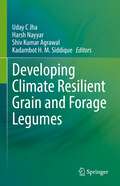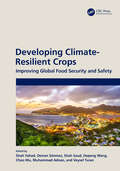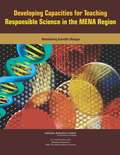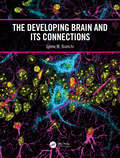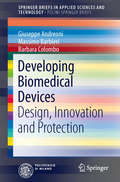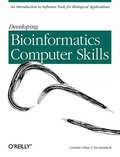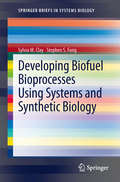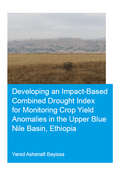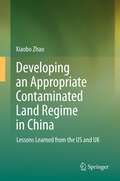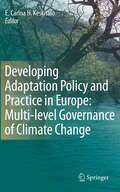- Table View
- List View
Developing Synthetic Transport Systems
by Alexey Melkikh Maria SutorminaUnderstanding the general laws of an effective system for the transport of substances in cells is an important goal of systems and synthetic biology and will help us to answer why the transport subsystem of a cell is arranged as it is. In addition, the construction of models for optimizing transport systems is of considerable importance in the early stages in the development of a functioning protocell. The aim of this book is to describe the latest techniques for the calculation of the optimal parameters of the transport subsystem of a cell at its maximum efficiency. The book will describe linear and nonlinear programming, dynamic programming, game theory for models of ion transport in different types of cells (e.g. mammalian cells, bacteria, plants and fungi).
Developing Sustainable Agriculture in Pakistan
by Iqrar Ahmad Khan Muhammad Sarwar KhanAgriculture plays a pivotal role in the economy and development of Pakistan providing food to consumers, raw materials to industries, and a market for industrial goods. Unfortunately, agricultural production is stagnant due to several barriers including a fixed cropping pattern, reliance on a few major crops, a narrow genetic pool, poor seed quality, and a changing climate. In addition, the high cost of production, weak phytosanitary compliance mechanisms, and a lack of cold chain facilities makes Pakistan agriculturally uncompetitive in export markets. Despite all these issues, agriculture is the primary industry in Pakistan and small farmers continue to dominate the business. Small farmers grow crops for subsistence under a fixed cropping pattern and a holistic approach is required to develop agriculture to improve the livelihoods of the rural populace. This book presents an exhaustive look at agriculture in Pakistan. Chapters provide critical analyses of present trends, inadequacies in agriculture, strategic planning, improvement programs and policies while keeping in view the natural resources, plant- and animal-related agricultural production technologies, input supplies, population planning, migration and poverty, and balanced policies on finance, credit, marketing, and trade.
Developing Sustainability Competences Through Pedagogical Approaches: Experiences from International Case Studies (Strategies for Sustainability)
by Rodrigo Lozano Maria Barreiro-GenThis book is aimed at developing sustainability competences through pedagogical approaches by comparing 15 case studies from 12 countries in 4 continents (Africa, America, Australia, and Europe) analysing how Sustainable Development (SD) is being taught in their courses, which competences are being developed, and which pedagogical approaches are being used to develop the competences. The book brings together practice-based original research on the connection between developing sustainability competences and the pedagogical approaches used, utilizing a framework aimed at helping educators in creating and updating their courses to provide a more complete, holistic, and systemic sustainability education to future leaders, decision makers, educators, and change agents. Compared to previous works addressing SD in education, which often mostly cover tools for improving the sustainability of campus operations, this approach uses assessment tools to uniquely focus on how courses and programmes (i.e. curricula) incorporate SD. Through the case studies, readers will learn about how the 3 major groups of pedagogical approaches have been used: (1) Universal, meaning broadly applicable pedagogies that have been used in many disciplines and contexts; (2) Community and social justice, which are pedagogies developed specifically for use in addressing social justice and community-building; and (3) Environmental education, which are pedagogies emerging from environmental sciences and environmental education practices.
Developing Senior Navy Leaders
by Herbert J. Shukiar Lawrence M. Hanser Bruce Newsome Louis W. MillerCould U.S. Navy officers be better prepared to become flag officers? This study examines the kinds of expertise required for successful performance in Navy flag billets, and whether recent pools of officers possess this experience. The authors also examine Navy trends over the past decade to identify the types of expertise likely to become more important for Navy leaders in the future.
Developing Scaffolds in Evolution, Culture, and Cognition (Vienna Series in Theoretical Biology #17)
by Linnda R. Caporael James R. Griesemer William C. WimsattEmpirical and philosophical perspectives on scaffolding that highlight the role of temporal and temporary resources in development across concepts of culture, cognition, and evolution."Scaffolding" is a concept that is becoming widely used across disciplines. This book investigates common threads in diverse applications of scaffolding, including theoretical biology, cognitive science, social theory, science and technology studies, and human development. Despite its widespread use, the concept of scaffolding is often given short shrift; the contributors to this volume, from a range of disciplines, offer a more fully developed analysis of scaffolding that highlights the role of temporal and temporary resources in development, broadly conceived, across concepts of culture, cognition, and evolution.The book emphasizes reproduction, repeated assembly, and entrenchment of heterogeneous relations, parts, and processes as a complement to neo-Darwinism in the developmentalist tradition of conceptualizing evolutionary change. After describing an integration of theoretical perspectives that can accommodate different levels of analysis and connect various methodologies, the book discusses multilevel organization; differences (and reciprocality) between individuals and institutions as units of analysis; and perspectives on development that span brains, careers, corporations, and cultural cycles.ContributorsColin Allen, Linnda R. Caporael, James Evans, Elihu M. Gerson, Simona Ginsburg, James R. Griesemer, Christophe Heintz, Eva Jablonka, Sanjay Joshi, Shu-Chen Li, Pamela Lyon, Sergio F. Martinez, Christopher J. May, Johann Peter Murmann, Stuart A. Newman, Jeffrey C. Schank, Iddo Tavory, Georg Theiner, Barbara Hoeberg Wimsatt, William C. Wimsatt
Developing Scaffolds in Evolution, Culture, and Cognition
by Linnda R. Caporael James R. Griesemer William C. Wimsatt"Scaffolding" is a concept that is becoming widely used across disciplines. This book investigates common threads in diverse applications of scaffolding, including theoretical biology, cognitive science, social theory, science and technology studies, and human development. Despite its widespread use, the concept of scaffolding is often given short shrift; the contributors to this volume, from a range of disciplines, offer a more fully developed analysis of scaffolding that highlights the role of temporal and temporary resources in development, broadly conceived, across concepts of culture, cognition, and evolution. The book emphasizes reproduction, repeated assembly, and entrenchment of heterogeneous relations, parts, and processes as a complement to neo-Darwinism in the developmentalist tradition of conceptualizing evolutionary change. After describing an integration of theoretical perspectives that can accommodate different levels of analysis and connect various methodologies, the book discusses multilevel organization; differences (and reciprocality) between individuals and institutions as units of analysis; and perspectives on development that span brains, careers, corporations, and cultural cycles. Contributors: Colin Allen, Linnda R. Caporael, James Evans, Elihu M. Gerson, Simona Ginsburg, James R. Griesemer, Christophe Heintz, Eva Jablonka, Sanjay Joshi, Shu-Chen Li, Pamela Lyon, Sergio F. Martinez, Christopher J. May, Johann Peter Murmann, Stuart A. Newman, Jeffrey C. Schank, Iddo Tavory, Georg Theiner, Barbara Hoeberg Wimsatt, William C. Wimsatt
The Developing Person Through the Life Span
by Kathleen Stassen BergerThis book is an authoritative, established text that engages students in the study of lifespan development from a chronological viewpoint.
Developing Nucleon Self-Energies to Generate the Ingredients for the Description of Nuclear Reactions (Springer Theses)
by Mack C. AtkinsonThis thesis develops the dispersive optical model into a tool that allows for the assessment of the validity of nuclear reaction models, thereby generating unambiguous removal probabilities of nucleons from valence orbits using the electron-induced proton knockout reaction. These removal probabilities document the substantial quantitative degree in which nuclei deviate from the independent-particle model description. Another outcome reported within is the prediction for the neutron distribution of Ca-40, Ca-48, and Pb-208. The neutron radii of these nuclei have direct relevance for the understanding of neutron stars and are currently the subject of delicate experiments. Unlike other approaches, the current method is consistent with all other relevant data and describes nuclei beyond the independent-particle model. Finally, a new interpretation of the saturation probabilities of infinite nuclear matter is proposed suggesting that the semi-empirical mass formula must be supplemented with a better extrapolation from nuclei to infinite matter.
Developing Novel Spinning Methods to Fabricate Continuous Multifunctional Fibres for Bioapplications (Springer Theses)
by Azadeh MirabediniThis book describes the development of three dimensional electroactive fibres using a novel coaxial wet-spinning approach from organic conductors in combination with non-conducting hydrogel polymers. This book also presents the characterization and evaluation of multiaxial biofibres in terms of mechanical, physical, electrochemical and biological properties, and explores their use in a diverse range of applications including implantable electrodes, drug delivery systems and energy-storage systems.In the first chapter, the author highlights the significance of engineering three dimensional fibres, introduces the involved hydrogels and organic conductors with emphasis on their biomedical application, and collects some of the previously established methods for fabrication of biofibres. In the second chapter, particular attention is given to the overall experimental fabrication methods and characterization analyses conducted in the work. Chapters three to five present the main findings of this work, in which readers will discover how novel hybrid hydrogel fibres with an inner core of chitosan and alginate were prepared and characterized, how graphene was incorporated into coaxial wet-spun biofibres, and how one-dimensional triaxial fibres were developed using a novel coaxial wet-spinning fibre production method and applied as potential battery devices. In the final chapter of this work, the author summarizes the main achievements of the work and outlines some recommendations for future research.
Developing Modular-Oriented Simulation Models Using System Dynamics Libraries
by William Ibbs Christian K. KarlThis SpringerBrief introduces the development and practical application of a module-oriented development framework for domain specific system-dynamic libraries (SDL approach), which can be used in the simulation of multi-causal and dynamic relationships on different levels of an industry, as an example the construction industry. Multidisciplinary research and development teams, scientists from different domains as well as practitioners can develop SDL units from varying perspectives based on this approach. For example, the explanation of the risk situation of a company, the identification and evaluation of project risks, endangered operational procedures on various functional levels, or to improve the understanding of the decision making process in detail. This book is an excellent source for researchers, programmers and practitioners. It enables the development of suitable simulation systems from the beginning and demonstrates that it is possible to connect the development of simulation models and daily work. It provides advanced-level students from different domains with a comprehensive overview and clear understanding of a new and valuable modeling technique.
Developing Insights in Cartilage Repair
by Pieter J. Emans Lars PetersonThis comprehensive book discusses cartilage repair and all its aspects. These aspects vary from basic insights in cartilage biology and regeneration via MRI, to results of existing cartilage repair techniques and upcoming novel approaches. Fundamental cartilage biology is the topic covered within the first chapters of the book. These chapters not only provide an insight in healthy, damaged and regenerative cartilage but also describe developments in gene therapy and methods to enhance chondrogenesis of stemcells and prevent hypertophic differentiation. There is a huge progress in the possibilities of MR imaging of both healthy, damaged and regenerative cartilage. These developments not only enable better monitoring of cartilage repair but may also unravel the pathophysiology of the development of cartilage defects. Different cartilage repair techniques (e. g. allografts, autologous chondrocytes transplantation [ACT], microfracture), there technical aspects (e. g. developments towards an total arthroscopic approach), pitfalls, and outcomes are reported in the following chapters. In these chapters factors important for the results of cartilage repair such as meniscal repair, patient factors are described. Finally, an overview of novel cartilage repair techniques such as minced cartilage, denovo cartilage and more areas are discussed in this comprehensive addition to the literature.
Developing The Environment: Problems & Management
by C J BarrowThis book presents a comprehensive overview of global environmental problems - past, present and future - examining their roots and implications and suggesting, where possible, ways in which they might be mitigated or avoided by careful management.
Developing Critical Thinking in Physics: The Apprenticeship of Critique (Contributions from Science Education Research #7)
by Laurence Viennot Nicolas DécampThis book promotes the effective implementation and development of critical analysis in physics. It focuses on explanatory texts concerning subjects typically dealt with in secondary or higher education and addressed in an academic or popular context. It highlights the general difficulties and obstacles inherent in teaching physics and shows how some tools can help to combine successful criticism and better understanding. The book examines the main reasons to call a text into question and looks at risk factors such as simplifications, story-like explanations and visual analogies. It takes inventory of the benefits and limits of critical analysis and discusses the complex links between conceptual mastery and critical attitude. The book ends by offering tools to activate critical thinking and ways for educators to guide students towards productive critical analysis.
Developing Climate Resilient Grain and Forage Legumes
by Uday C Jha Harsh Nayyar Shiv Kumar Agrawal Kadambot H. M. SiddiqueThis edited book covers all aspects of grain legumes including negative impact of abiotic and biotic stresses under the changing global climate. It discusses the role of various subject disciplines ranging from plant breeding, genetics, plant physiology, molecular biology, and genomics to high-throughput phenotyping and other emerging technologies for sustaining global grain and fodder legume production to alleviate impending global food crises. The book offers strategies to ensure plant-based dietary protein security across the globe. It covers all major commercial legume crops used as food, feed and fodder. This book is targeted to graduate and postgraduate students, researchers, progressive farmers and policymakers to inform them of the importance of cultivating grain and fodder legumes for future global food and nutritional security and for maintaining sustainable ecosystem.
Developing Climate-Resilient Crops: Improving Global Food Security and Safety (Footprints of Climate Variability on Plant Diversity)
by Shah FahadDeveloping Climate-Resilient Crops: Improving Global Food Security and Safety is timely, as the world is gradually waking up to the fact that a global food crisis of enormous proportions is brewing. Climate change is creating immense problems for agricultural productivity worldwide, resulting in higher food prices. This book elucidates the causative aspects of climate modification related to agriculture, soil, and plants, and discusses the relevant resulting mitigation process and also how new tools and resources can be used to develop climate-resilient crops. Features: Addresses the limits of the anthropogenic global warming theory advocated by the Intergovernmental Panel on Climate Change Presents the main characters (drought tolerance, heat tolerance, water-use efficiency, disease resistance, nitrogen-use efficiency, nitrogen fixation, and carbon sequestration) necessary for climate-resilient agriculture Delivers both theoretical and practical aspects, and serves as baseline information for future research Provides valuable resource for those students engaged in the field of environmental sciences, soil sciences, agricultural microbiology, plant pathology, and agronomy Highlights factors that are threatening future food production
Developing Capacities for Teaching Responsible Science in the MENA Region
by Committee on Developing a Framework for an International Faculty Development Project on Education About Research in the Life Sciences with Dual Use Potential National Research Council Board on Life Science Division on Earth and Life Studies The World Academy of SciencesSpurred on by new discoveries and rapid technological advances, the capacity for life science research is expanding across the globe--and with it comes concerns about the unintended impacts of research on the physical and biological environment, human well-being, or the deliberate misuse of knowledge, tools, and techniques to cause harm. This report describes efforts to address dual use issues by developing institutes around the world that will help life sciences faculty learn to teach about the responsible conduct of science. Based on the successful National Academies Summer Institute for Undergraduate Biology Education and on previous NRC reports on effective methods for teaching about dual use issues, the report's authoring committee designed a general framework for the faculty institutes and chose the Middle East-North Africa (MENA) region to test a prototype faculty institute. In September 2012, the first Institute was held in Aqaba, Jordan, bringing together 28 participants from Algeria, Egypt, Jordan, Libya, and Yemen to engage with effective, evidence-based teaching methods, develop curricular materials for use in their own classrooms, and become community leaders on dual use and related topics. Developing Capacities for Teaching Responsible Science in the MENA Region: Refashioning Scientific Dialogue offers insights from the institute that will help in the design and implementation of future programs in the MENA region, and in other parts of the world.
The Developing Brain and its Connections
by Lynne M. BianchiThe Developing Brain and Its Connections describes the processes of neural development from neural induction through synaptic refinement. Each chapter explores specific mechanisms of development and describes key experiments from invertebrate and vertebrate animal models. By highlighting experimental methods and explaining how hypotheses evolve over time, readers learn essential facts while strengthening their appreciation of the scientific method. Discussions of neurodevelopmental disorders and therapeutic approaches to them bridge basic science discoveries with the clinical aspects of the field. Descriptions of recent work by student researchers and medical residents demonstrate career pathways and options for those interested in pursuing any area neural development. With this distinctive approach, easy-to-follow writing style, and clear illustrations, The Developing Brain presents an accessible approach to neural development for undergraduate students. Related TitlesLuo, L. Principles of Neurobiology, 2nd edition (ISBN 9780815346050)Simon, S. A., series ed. Frontiers in Neuroscience https://www.routledge.com/Frontiers-in-Neuroscience/book-series/CRCFRONEUSCI Feltz, A., ed. Physiology of Neurons (ISBN 978-0-8153-4600-5)
Developing Biomedical Devices
by Giuseppe Andreoni Massimo Barbieri Barbara ColomboDuring the past two decades incredible progress has been achieved in the instruments and devices used in the biomedical field. This progress stems from continuous scientific research that has taken advantage of many findings and advances in technology made available by universities and industry. Innovation is the key word and in this context legal protection and intellectual property rights (IPR) are of crucial importance. This book provides students and practitioners with the fundamentals for designing biomedical devices and explains basic design principles. Furthermore, as an aid to the development of devices and products for healthcare, it presents a brief description of the human body, covering anatomy and physiology, that will assist the reader in understanding the origin of biosignals, their significance and the technology to be used in their measurement. Issues concerning IPR and protections are also fully discussed, with examples and opportunities for IPR exploitation.
Developing Bioinformatics Computer Skills
by Cynthia Gibas Per JambeckBioinformatics--the application of computational and analytical methods to biological problems--is a rapidly evolving scientific discipline. Genome sequencing projects are producing vast amounts of biological data for many different organisms, and, increasingly, storing these data in public databases. Such biological databases are growing exponentially, along with the biological literature. It's impossible for even the most zealous researcher to stay on top of necessary information in the field without the aid of computer-based tools. Bioinformatics is all about building these tools. Developing Bioinformatics Computer Skills is for scientists and students who are learning computational approaches to biology for the first time, as well as for experienced biology researchers who are just starting to use computers to handle their data. The book covers the Unix file system, building tools and databases for bioinformatics, computational approaches to biological problems, an introduction to Perl for bioinformatics, data mining, and data visualization. Written in a clear, engaging style, Developing Bioinformatics Computer Skills will help biologists develop a structured approach to biological data as well as the tools they'll need to analyze the data.
Developing Bioinformatics Computer Skills
by Per Jambeck Cynthia GibasIntroduces the field of bioinformatics: "the application of computational and analytical methods to biological problems.
Developing Biofuel Bioprocesses Using Systems and Synthetic Biology
by Sylvia M. Clay Stephen S. FongAdvances in technological and analytical methods have fostered rapid growth of systems biology and synthetic biology. There continues to be rapid changes and discoveries in both fields with a small number of recent peer-reviewed reviews indicating some of the relationships between systems biology and synthetic biology. This proposed SpringerBrief will cover core concepts of systems biology and synthetic biology and illustrate the implementation of associated research methodologies for an integrated approach to specifically address engineering microorganisms for biofuel production.
Developing an Impact-Based Combined Drought Index for Monitoring Crop Yield Anomalies in the Upper Blue Nile Basin, Ethiopia (IHE Delft PhD Thesis Series)
by Yared A. BayissaHaving a robust drought monitoring system for Ethiopia is crucial to mitigate the adverse impacts of droughts. Yet, such monitoring system still lacks in Ethiopia, and in the Upper Blue Nile (UBN) basin in particular. Several drought indices exist to monitor drought, however, these indices are unable, individually, to provide concise information on the occurrence of meteorological, agricultural and hydrological droughts. A combined drought index (CDI) using several meteorological, agricultural and hydrological drought indices can indicate the occurrence of all drought types, and can provide information that facilitates the drought management decision-making process. This thesis proposes an impact-based combined drought index (CDI) and a regression prediction model of crop yield anomalies for the UBN basin. The impact-based CDI is defined as a drought index that optimally combines the information embedded in other drought indices for monitoring a certain impact of drought, i.e. crop yield for the UBN. The developed CDI and the regression model have shown to be effective in indicating historic drought events in UBN basin. The impact-based CDI could potentially be used in the future development of drought monitoring in the UBN basin and support decision making in order to mitigate adverse drought impacts.
Developing an Appropriate Contaminated Land Regime in China
by Xiaobo ZhaoLike all industrialized countries, China has encountered increasing problems with land contamination in recent years. Abandoned mining and manufacturing sites and obsolete industrial complexes, while also creating new polluting industrial enterprises, represent impending environmental threats. More importantly, a number of social and economic problems have developed and must be dealt with, in some cases urgently. Contaminated land laws and regulations have been established and have evolved in the US and UK and many other jurisdictions over the past few decades. These regimes have substantially influenced the relevant legislation in the context of numerous Asian and European countries and will inevitably benefit similar legislative efforts in China. This book is the first monograph that focuses on how China can learn from the US and UK with respect to contaminated land legislation and comprehensively illustrates how contaminated land law could be created in China. It will be of interest to academics and practitioners in environmental law in China, as well as the US and UK.
Developing Adaptation Policy and Practice in Europe: Multi-level Governance of Climate Change
by E. Carina KeskitaloMitigation will not be sufficient for us to avoid climate change and we will need to adapt to its consequences. This book targets the development of adaptation policy in European countries with different relations between central and regional/local government.
